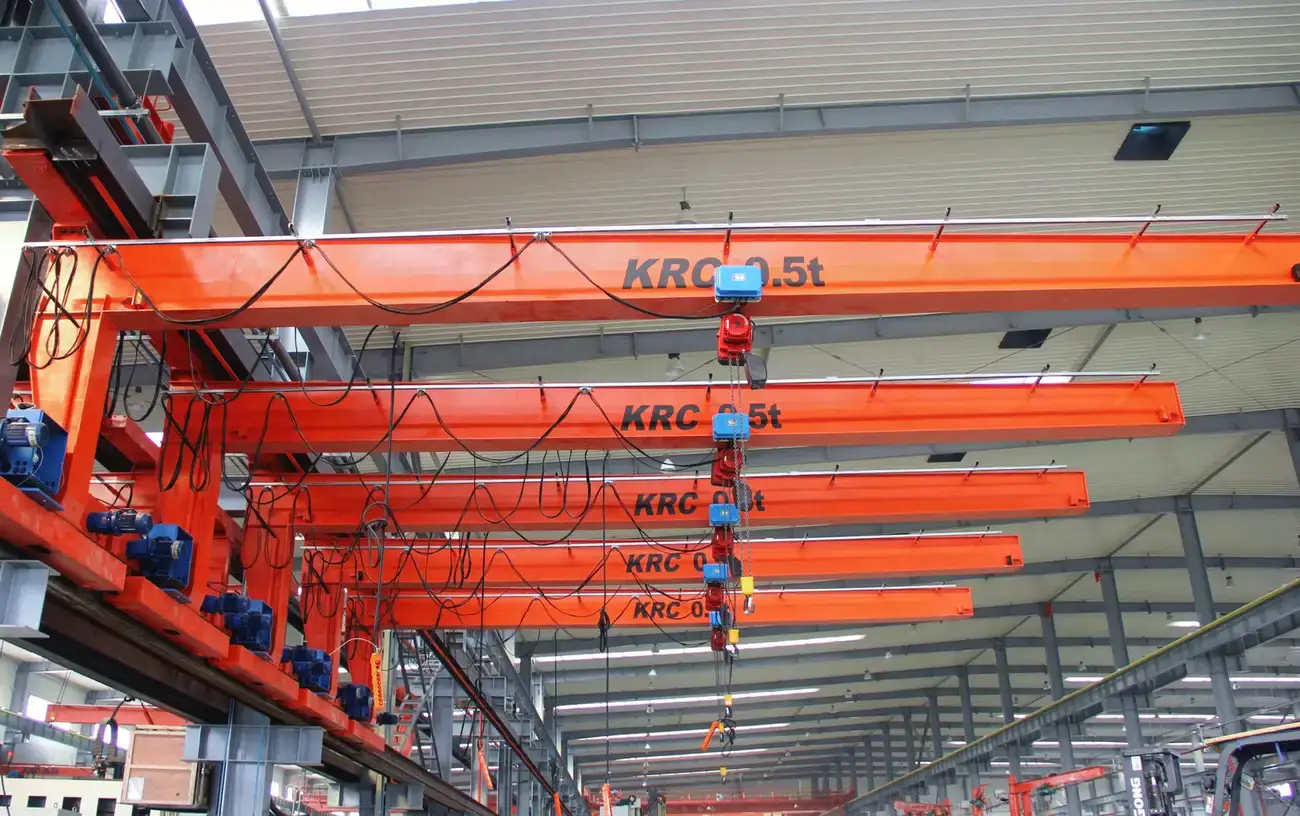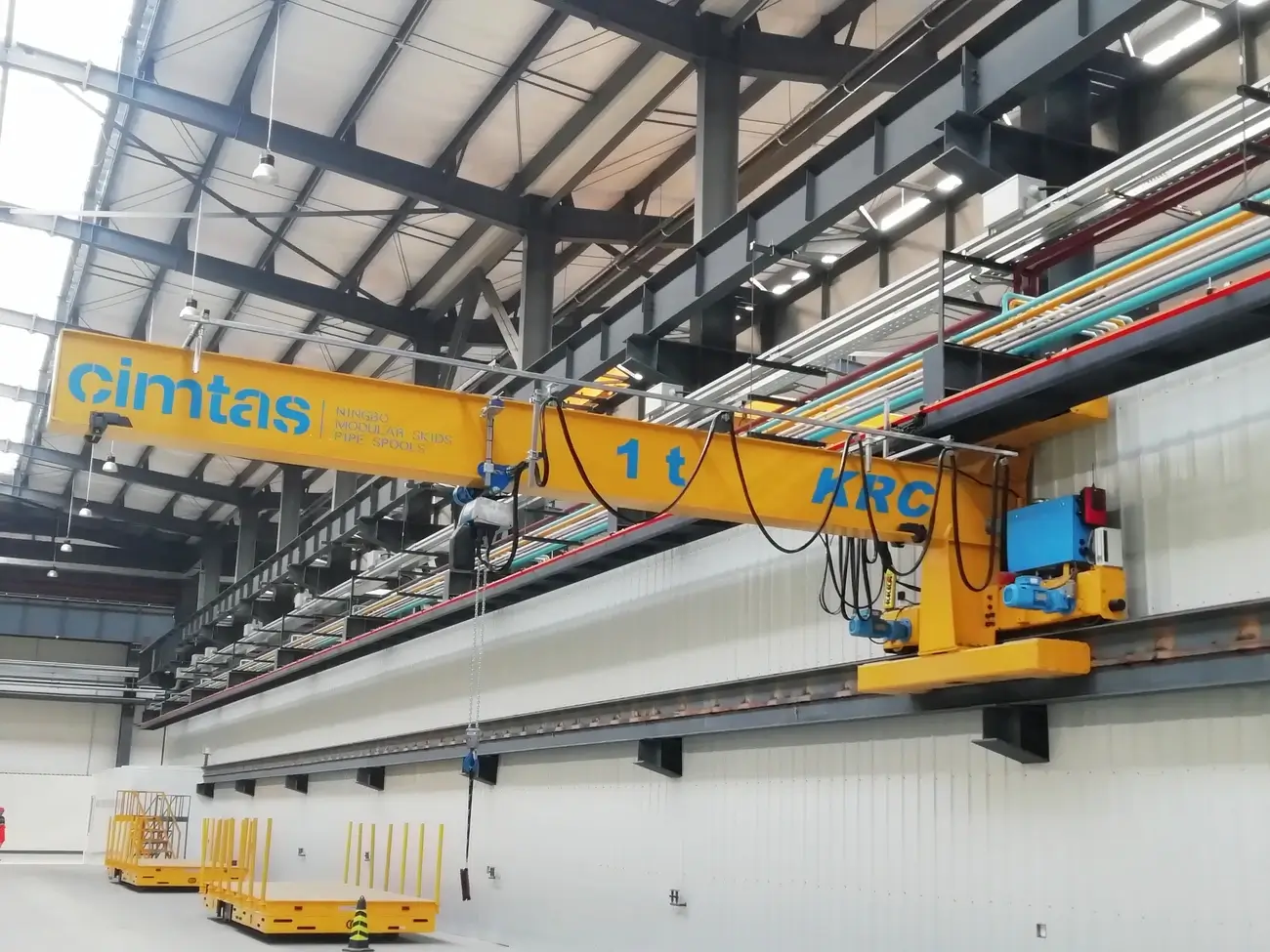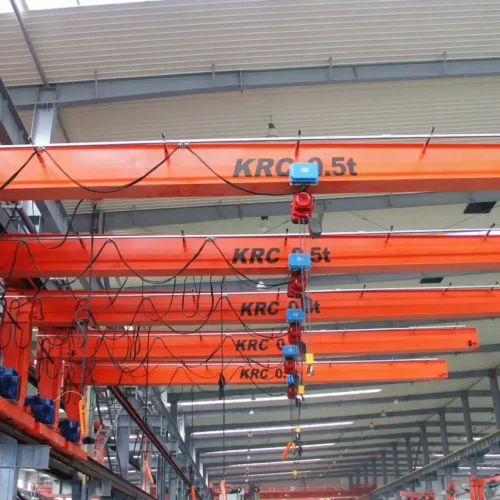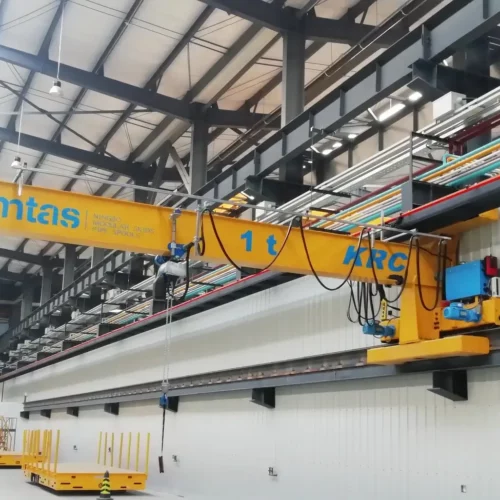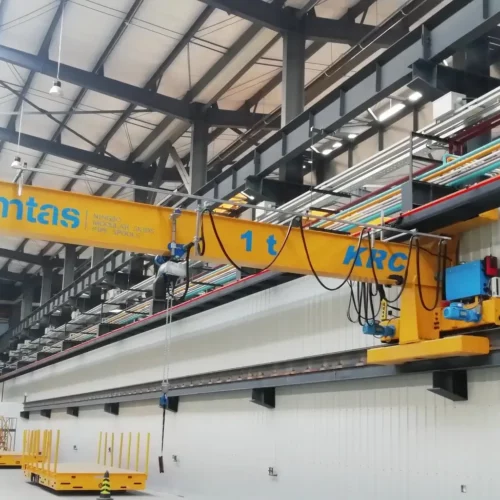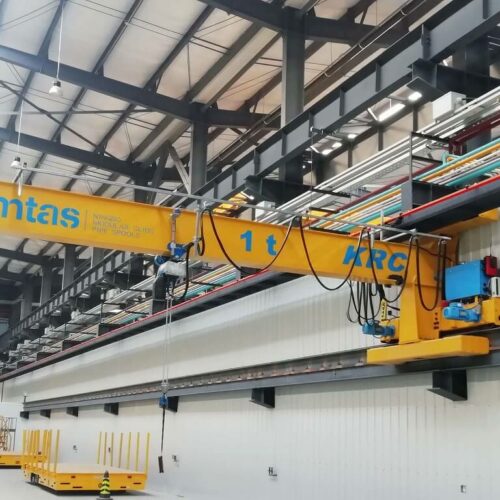wall mount jib crane Safety Certifications
Wall mount jib cranes play a crucial role in material handling and operations within various industrial settings. Ensuring their safe and reliable use requires adherence to specific safety certifications and standards. Here are some key safety certifications applicable to wall mount jib cranes:
1. OSHA (Occupational Safety and Health Administration):
– OSHA sets general industry and construction standards for crane operation and safety (29 CFR 1910 for General Industry and 29 CFR 1926 for Construction). Compliance with these regulations helps minimize workplace hazards and ensure safe operation.
2. ANSI/ASME (American National Standards Institute / American Society of Mechanical Engineers):
– Standards such as ANSI/ASME B30.11 set forth requirements for the design, inspection, maintenance, and operation of overhead and gantry cranes, including wall mount jib cranes. Adhering to these standards ensures that cranes are built and maintained to rigorous safety and performance benchmarks.
3. CMAA (Crane Manufacturers Association of America):
– CMAA establishes guidelines for the design, performance, and maintenance of cranes through its Specification No. 74, which provides detailed recommendations for jib cranes. This helps ensure structural integrity and operational safety.
4. ISO (International Organization for Standardization):
– ISO 9927 outlines the requirements for crane inspections. Regular inspections and maintenance per ISO standards help detect and mitigate potential issues before they lead to failures or accidents.
5. CE Marking (Conformité Européenne):
– For cranes used within the European Economic Area (EEA), the CE marking signifies compliance with EU safety, health, and environmental protection requirements. This involves conformity assessment procedures as per the Machinery Directive 2006/42/EC.
6. LOLER (Lifting Operations and Lifting Equipment Regulations):
– In the UK, LOLER provides specific regulations governing the safe use of lifting equipment, including jib cranes. Adherence ensures that lifting operations are properly planned, operated, and maintained.
By adhering to these safety certifications and guidelines, manufacturers and operators of wall mount jib cranes can ensure a safe working environment, enhance equipment reliability, and reduce the risk of accidents.
List Reference Technical Parameters of “wall mount jib crane”
A wall mount jib crane is a versatile piece of lifting equipment commonly used in industrial environments. Below are the key technical parameters:
1. Load Capacity:
– Ranges typically from 0.5 tons to 5 tons.
– Specifies the maximum weight the jib crane can lift.
2. Boom Length (Span):
– Typically varies from 2 to 10 meters.
– Determines the maximum reach of the crane.
3. Height Under Boom:
– Refers to the vertical distance from the floor to the underside of the boom.
– Generally customizable based on installation requirements.
4. Rotation Angle:
– Often 180 degrees for wall-mounted models.
– Defines the arc through which the jib can rotate.
5. Wall Bracket/Tie Rod:
– Connects the crane to the wall for stability and support.
– Constructed of robust materials like steel.
6. Boom Construction:
– Typically made of high-strength steel.
– May include I-beams or other structural enhancements for added rigidity.
7. Mounting Requirements:
– Requires a structurally sound wall capable of supporting the crane and its loads.
– Anchoring hardware and installation are crucial for safety.
8. Load Trolley:
– Manually operated or powered trolleys are used to move the load along the boom.
– Capacity must match the crane’s load rating.
9. Hoist Compatibility:
– Designed to work with electric, pneumatic, or manual chain hoists.
– Must align with the load capacity and operational requirements.
10. Surface Finish:
– Often coated with industrial-grade paint for corrosion resistance.
– Ensures durability in harsh environments.
11. Electrical Requirements:
– If equipped with powered rotation or hoists, electrical wiring specifications must be met.
– Generally involves standard industrial power supply configurations.
12. Safety Features:
– Load limiters, overload protection, and emergency stop mechanisms.
– Essential for preventing accidents and ensuring safe operation.
By understanding these technical parameters, one can better select and configure a wall mount jib crane to meet specific operational needs.
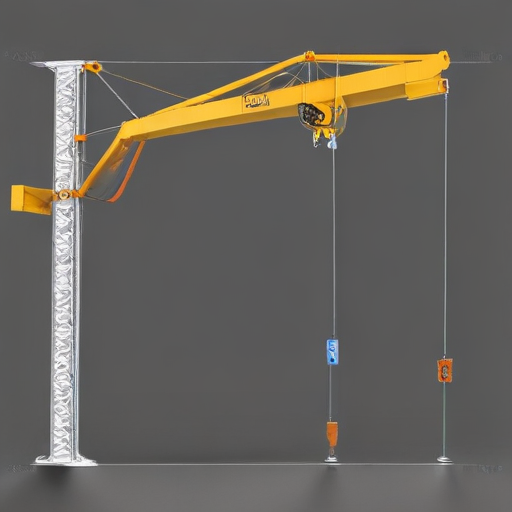
List Product features of “wall mount jib crane”
A wall mount jib crane is a versatile and efficient lifting device designed to optimize space and improve workflow. Here are the key features of a wall mount jib crane:
1. Space-Saving Design: Mounts directly to a wall or column which frees up valuable floor space, making it ideal for cramped or crowded work areas.
2. Wide Range of Capacities: Available in various load capacities to handle different lifting needs, typically ranging from 100 lbs to several tons.
3. Durable Construction: Made with high-grade materials such as steel to ensure longevity and reliable performance in demanding environments.
4. Adjustable Boom Length: The jib arm, or boom, can usually be adjusted to different lengths to accommodate various workspace dimensions and lifting needs.
5. Rotational Capabilities: Typically offers up to 180 degrees of rotation, enabling workers to move materials easily within a semi-circular work area.
6. Customizable Options: Often available with several customization options including different boom heights, lengths, and mounting configurations.
7. Ease of Installation: Can be installed on most sturdy vertical surfaces with the appropriate mounting hardware, simplifying the setup process.
8. Enhanced Safety: Equipped with safety features like overload protection, secure mounting, and quality-certified parts to ensure safe operation.
9. Smooth Operation: Designed for minimal resistance and smooth movement, often with precision bearings and ergonomic controls.
10. Versatile Applications: Suitable for a wide variety of applications including manufacturing, warehousing, and assembly lines.
11. Reduced Worker Fatigue: Allows for the easy lifting and transporting of heavy materials, helping to reduce worker strain and improve productivity.
12. Cost-Effective: Offers an economical lifting solution with lower initial investment compared to more complex crane systems.
These features collectively make wall mount jib cranes an efficient, reliable, and cost-effective solution for various lifting and material handling needs.
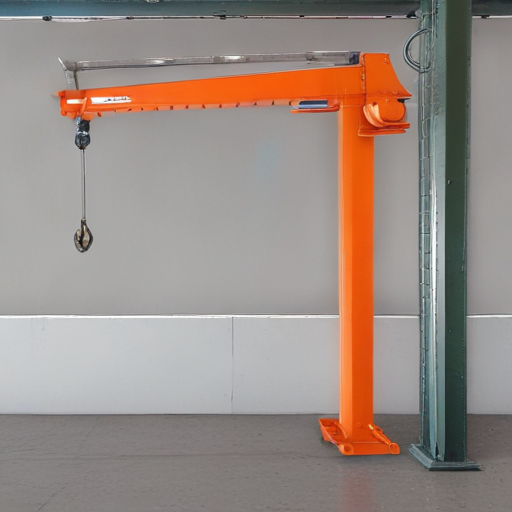
List Various Types of “wall mount jib crane”
Wall mount jib cranes are versatile lifting devices that depend on mounting to vertical surfaces, providing efficient material handling solutions while saving floor space. Here are various types:
1. Articulating Wall Mount Jib Crane:
– Description: Features two swivel arms, offering greater range of motion and flexibility.
– Advantages: Ideal for navigating around obstacles; suitable for multiple tasks in confined spaces.
2. Cantilever Wall Mount Jib Crane:
– Description: An upper and lower wall bracket support the boom, offering consistent lifting capacity along its full length.
– Advantages: Provides maximum hoist lift for increased flexibility; commonly used in production lines and workstations.
3. Wall Bracket Jib Crane:
– Description: Similar to the cantilever type but often more lightweight; bracket-mounted to the wall, allowing it to support moderate loads.
– Advantages: Economical and effective for lighter loads; easy to install and maintain.
4. Wall Traveling Jib Crane:
– Description: Mounted on a wall track, enabling it to traverse long lengths along the wall.
– Advantages: Covers large working areas; can be integrated with overhead cranes or other equipment for complex workflows.
5. Freestanding Wall Mount Jib Crane:
– Description: Although primarily a wall mount, it features a base that provides additional support independently from the wall.
– Advantages: Combines the benefits of wall and freestanding models; suitable for areas where structural support is limited.
Selecting the right type involves considering factors like weight capacity, reach, flexibility, and the specific workspace configuration. The choice depends on the nature of the tasks, frequency of use, and integration with existing infrastructure.
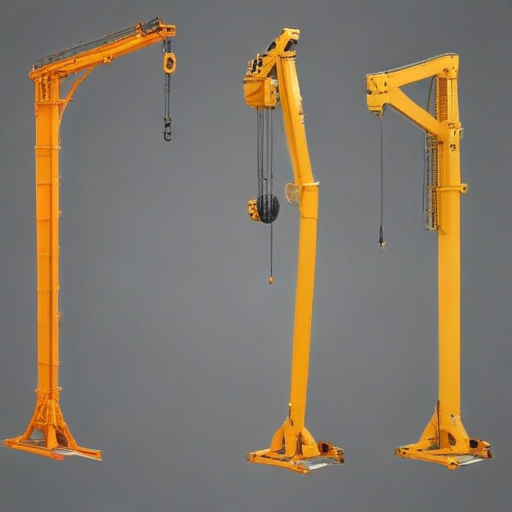
List Application of “wall mount jib crane”
Wall mount jib cranes are versatile lifting devices used in a range of settings for material handling, increasing efficiency and enhancing safety. Here are some key applications:
1. Manufacturing Units: In production lines, wall mount jib cranes assist in moving heavy parts or assemblies between workstations, reducing manual labor and expediting processes.
2. Warehousing: These cranes help in the loading and unloading of goods, organizing inventory, and optimizing storage space by effectively handling bulky items.
3. Automotive Industry: Used for lifting engines, transmissions, and other heavy vehicle components during assembly, maintenance, or repair operations.
4. Workshops: In various workshops, including metalworking and woodworking shops, these cranes lift and maneuver heavy raw materials, tools, and finished products.
5. Construction Sites: Employed for hoisting construction materials like steel beams, panels, and other heavy components, minimizing worker strain and enhancing site safety.
6. Marine and Docks: Used for transferring cargo, equipment, and supplies between ships and the dock, as well as for ship maintenance tasks.
7. Railway Maintenance: Facilitates the lifting and positioning of heavy railway components such as wheels, axles, and engines during repair and maintenance.
8. Chemical and Pharmaceutical Plants: Helps in handling heavy containers and equipment, ensuring safe and efficient material transfer in potentially hazardous environments.
9. Food Industry: Assists in the processing, packaging, and transportation of heavy food products, machinery, and containers, adhering to hygiene and safety standards.
10. Mining Operations: Utilized for lifting and moving heavy mining tools, machinery, and extracted materials.
11. Aerospace: Aids in the assembly and maintenance of aircraft parts, ensuring precision and safety due to their ease of maneuverability and consistent load handling.
These varied applications demonstrate the adaptability of wall mount jib cranes in enhancing operational efficiency, safety, and productivity across multiple industries.
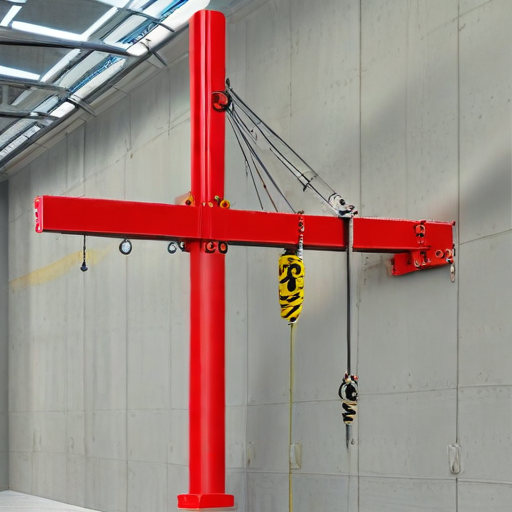
List Buyer Types of “wall mount jib crane”
Buyers of wall mount jib cranes come from various industries and have diverse requirements. Generally, these buyers can be categorized into the following types:
1. Manufacturing Facilities:
– Automotive: These facilities use wall mount jib cranes for moving heavy auto parts and assemblies.
– Metal Fabrication: They rely on these cranes for handling sheets of metal, and finished products.
– Equipment Manufacturers: Include sectors like aerospace and machinery manufacturers requiring precise handling of heavy components.
2. Warehousing and Distribution Centers:
– Use the cranes to move bulky items in and out of storage or for loading and unloading trucks. They often handle various packaged goods and products requiring efficient material handling solutions.
3. Maintenance Workshops:
– Industrial repair and maintenance centers leverage wall mount jib cranes for lifting and moving heavy equipment and parts, ensuring smooth maintenance operations.
4. Construction Sites:
– Used during the assembly and installation of large structures and machinery, ensuring materials are positioned accurately and safely.
5. Marine and Port Operations:
– At docks and shipyards for the handling of cargo, ship parts, and maintenance of vessels. They require cranes that can manage heavy and irregular loads.
6. Energy and Utilities:
– Power plants, wind farms, and other utility providers utilize these cranes for maintaining and installing heavy equipment and components.
7. Pharmaceutical and Chemical Industries:
– These industries require cranes for handling heavy reactors, mixers, and other manufacturing equipment ensuring material outflows are seamless.
8. Aerospace:
– Use cranes for handling aircraft components and assemblies in both the production and maintenance processes.
9. Custom and Specialized Facilities:
– Includes workshops and facilities requiring custom material handling solutions, often tailored to specific industries like woodworking, or artistic metalworking.
10. Retail Outlets:
– Particularly those with large stocks of bulky goods like home improvement stores using cranes to handle inventory efficiently.
These diverse applications underscore the adaptability and utility of wall mount jib cranes across various sectors needing efficient and ergonomic solutions for handling heavy loads.
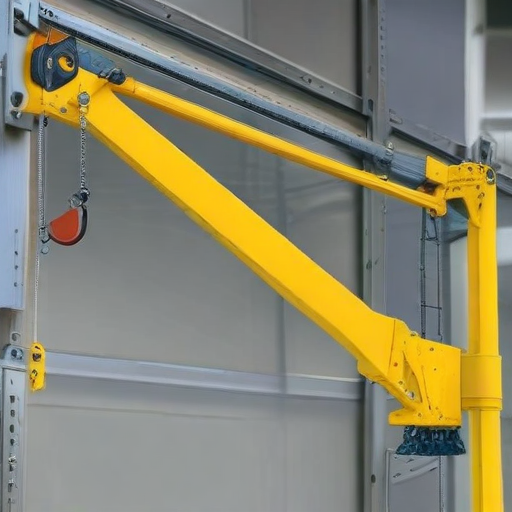
List “wall mount jib crane” Project Types for Different Industries
Certainly! Wall mount jib cranes are versatile lifting solutions that can be tailored for various industries to meet their specific needs. Here are some project types for different industries:
1. Manufacturing:
– Workstation Assembly: To assist in lifting components for assembly lines.
– Material Handling: For moving raw materials and finished products in and out of processing areas.
2. Warehousing and Logistics:
– Inventory Management: Facilitates the organization and retrieval of goods in storage locations.
– Loading and Unloading: Assists in loading and unloading trucks or shipping containers.
3. Automotive:
– Engine Lifting: For installing or removing engines in vehicle assembly or repair areas.
– Parts Positioning: Assists in the placement of heavy parts like car doors or transmission systems.
4. Chemical and Pharmaceutical:
– Reactor Maintenance: Helps in the maintenance of heavy machinery such as reactors and mixers.
– Safe Handling of Chemical Drums: For safely moving heavy chemical drums to different production stages.
5. Construction:
– Batch Plant Loading: Assists in loading raw materials into batching plants.
– Concrete Molding: For handling molds and reinforcements in prefabrication.
6. Marine and Ports:
– Ship Maintenance: To lift and position heavy components during ship repair and maintenance.
– Cargo Transfer: For transferring goods between ships and docks efficiently.
7. Food and Beverage:
– Ingredient Handling: For moving bulk ingredients to mixers or other processing equipment.
– Packaging Lines: To assist in packaging and palletizing heavy products.
8. Aerospace:
– Tooling and Fixture Lifting: Moves specialized tools and fixtures required for aircraft part assembly.
– Component Handling: For maneuvering large, delicate components like wings or fuselage sections.
9. Energy and Utilities:
– Equipment Maintenance: Helps in the maintenance of heavy electrical transformers or generator parts.
– Pipeline Construction: Assists in the positioning and welding of heavy pipeline sections.
10. Healthcare:
– Medical Equipment Handling: For the lifting and installation of large medical equipment like MRI machines.
– Sterile Processing Departments: Assists in the handling of heavy sterilization equipment.
These applications demonstrate the versatility and essential role wall mount jib cranes play in enhancing operational efficiency and safety across diverse industries.
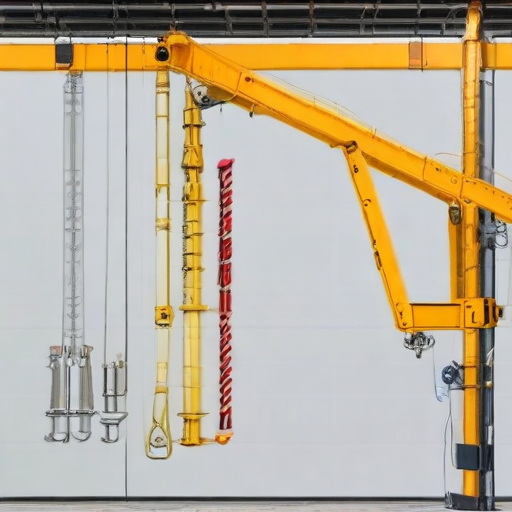
wall mount jib crane Accessories Upgrades and Custom Manufacturing Options
Upgrading a wall mount jib crane can significantly enhance its performance and versatility. Here are several accessories and customization options to consider:
Accessories:
1. Electric Hoists: Streamline lifting operations by replacing manual hoists with electric ones. This upgrade increases efficiency and reduces operator fatigue.
2. Variable Speed Control: Provides precise load handling by allowing operators to adjust lifting and lowering speeds.
3. Trolley Systems: Manual or motorized trolleys ensure smooth horizontal movement along the jib’s arm, enhancing operational fluidity.
4. End Stops: Prevent trolley overrun, adding a layer of safety to operations.
5. Festoon Systems: Manage power cords and control cables efficiently, reducing the risk of entanglement and wear.
Upgrades:
1. Increased Load Capacity: Strengthening the structure to handle heavier loads can make your jib crane more versatile for various industrial applications.
2. Extended Boom Reach: Customizing the length of the jib’s arm to suit specific spatial constraints or operational needs.
3. Articulating Arm: Offers enhanced flexibility, allowing the arm to reach around obstacles, thus broadening the range of motion.
4. Slip Ring Assemblies: Enable continuous 360-degree rotation, maximizing the crane’s operational range without the worry of cable entanglement.
Custom Manufacturing Options:
1. Material Choices: Opting for stainless steel or aluminum construction to meet specific environmental or hygiene standards (e.g., food processing or pharmaceutical environments).
2. Custom Paint and Coatings: Tailored finishes to withstand harsh environmental conditions such as extreme temperatures, corrosion, or chemical exposure.
3. Integrated Safety Features: Incorporating load limiters, emergency stop controls, and other safety mechanisms tailored to the working environment’s needs.
Conclusion:
Investing in accessories and custom manufacturing options for a wall mount jib crane can lead to improved efficiency, safety, and adaptability. Whether upgrading components or customizing the entire crane, these enhancements ensure the equipment meets specific operational demands.
List Quality Control and The Manufacturing Process of “wall mount jib crane”
Quality Control
1. Material Inspection: Verify raw materials like steel for compliance with specifications.
2. Dimensional Accuracy: Measure and ensure components meet design dimensions.
3. Load Testing: Conduct load capacity tests to verify structural integrity.
4. Welding Inspection: Check welds for defects using visual inspection and non-destructive testing (NDT).
5. Coating Quality: Inspect paint or powder coating for uniformity and adhesion.
6. Component Testing: Assess performance of motors, gears, and electrical systems.
7. Final Assembly Check: Ensure all parts are correctly assembled and functioning.
8. Documentation Review: Maintain detailed records of inspections and tests.
Manufacturing Process
1. Design: Engineers create detailed drawings and specifications.
2. Material Procurement: Acquire high-quality steel and components.
3. Cutting and Machining: Cut steel to size using CNC machines for precision.
4. Welding: Weld parts together using MIG or TIG welding, followed by inspection.
5. Machining and Drilling: Further machining like drilling holes for mounting.
6. Surface Preparation: Clean surfaces; sandblast if needed for optimal coating adherence.
7. Coating: Apply paint or powder coating for corrosion resistance.
8. Assembly: Assemble components including the jib arm, base plate, and motor mechanism.
9. Electrical Installation: Install and wire electrical components.
10. Testing: Perform mechanical and load tests to ensure the crane meets safety standards.
11. Quality Inspection: Conduct thorough inspections of the assembled unit.
12. Packaging: Pack the crane securely for transport.
13. Shipping: Dispatch to customers with all documentation.
This streamlined approach helps ensure the wall mount jib crane is manufactured to high-quality standards, ensuring safety and reliability.
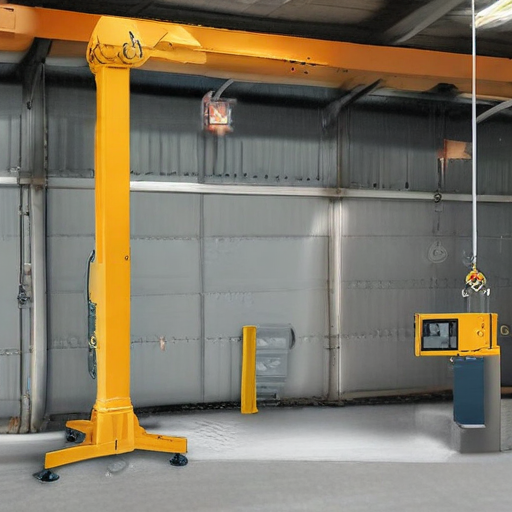
How to use “wall mount jib crane”
A wall mount jib crane is a versatile lifting solution often used in workshops, factories, and garages for material handling tasks. Here’s a step-by-step guide on how to use it:
1. Installation: Ensure the wall mount jib crane is properly installed on a sturdy wall or pillar capable of supporting the load. Follow the manufacturer’s guidelines for installation.
2. Inspection: Before using the crane, inspect all components, including the arm, hoist, trolley, and mounting bolts, for any signs of wear or damage. Check for proper lubrication in moving parts.
3. Load Assessment: Determine the weight of the load to be lifted. Ensure it does not exceed the crane’s rated capacity, which is usually marked on the equipment.
4. Rigging: Use appropriate lifting slings, chains, or other rigging equipment compatible with the load. Attach them securely to the load and ensure they are balanced.
5. Hoisting: Use the hoist to lift the load slowly and steadily. Modern cranes often have electric or manual hoists with simple controls.
6. Rotating the Boom: Once the load is hoisted to the desired height, use the jib arm to swing the load to the desired location. The jib crane’s arm can typically rotate 180 degrees or more, depending on the model.
7. Positioning: Carefully lower the load into its new position by operating the hoist controls. Make sure to guide the load smoothly and avoid sudden movements.
8. Unrigging: Once the load is securely placed, detach the slings or chains carefully from the load.
9. Safety Precautions: Always wear appropriate personal protective equipment (PPE) like gloves, hard hats, and safety shoes. Follow all safety protocols and never stand under a suspended load.
10. Shut Down: Turn off the hoist and perform a final inspection of the crane to ensure everything is in proper working order.
By following these steps, you can safely and efficiently use a wall mount jib crane for lifting tasks.
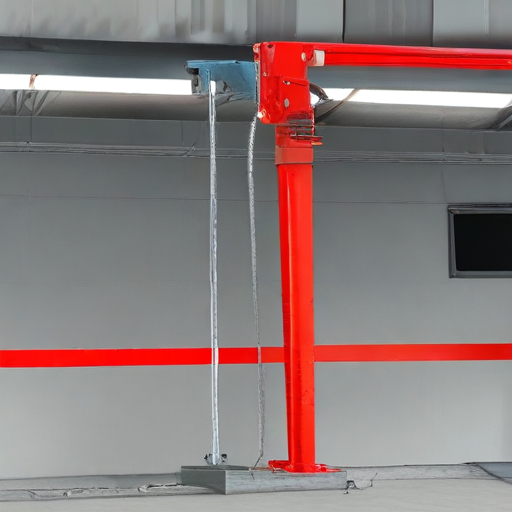
“wall mount jib crane” Comparative Analysis
A wall mount jib crane is an efficient lifting device commonly used in various industries for moving materials within a specific radius. Here’s a comparative analysis of wall mount jib cranes focusing on their advantages, disadvantages, and key considerations:
Advantages:
1. Space Saving: Wall mount jib cranes are installed on existing walls or columns, which frees up floor space and provides greater flexibility in layout design.
2. Cost-Effective: Typically, these cranes are less expensive than standalone cranes or gantry cranes because they utilize existing structural supports.
3. Ease of Installation: As they require less structural work, installation is relatively straightforward and less time-consuming.
4. Versatility: Ideal for operations that necessitate repetitive lifting in a confined area, such as workshops, production lines, and maintenance shops.
5. High Load Capacity: Depending on the model and structural integrity of the mounting surface, they can handle substantial loads ranging from a few hundred pounds to several tons.
Disadvantages:
1. Dependency on Wall Strength: The structural integrity of the mounting wall is crucial. Weak walls may not support the crane’s load, limiting applicability.
2. Limited Movement: They provide lifting and horizontal movement within a specified radius but cannot cover wide areas like freestanding or gantry cranes.
3. Potential Obstructions: Wall-mounted installations can sometimes interfere with existing infrastructure like pipes or conduits.
Key Considerations:
1. Load Requirements: Assess the weight and type of loads to select the appropriate model.
2. Wall Integrity: Ensure the mounting wall or column can support both the crane and its load.
3. Reach and Rotation: Evaluate the required span and degree of rotation to pick a crane that meets operational needs.
4. Installation and Maintenance: Consider ease of installation and access for maintenance work.
5. Safety Features: Opt for cranes with essential safety features such as emergency stops, load limiters, and quality hoisting mechanisms.
Conclusion:
Wall mount jib cranes offer a practical and economical solution for material handling within limited spaces, provided the installation criteria are met. They excel in environments where space is a premium, though careful assessment of wall strength and operational needs is critical for ensuring safety and efficiency.
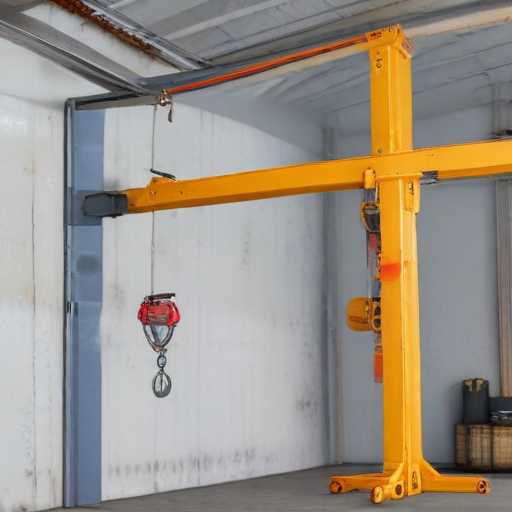
“wall mount jib crane” Warranty and Support
Warranty and Support for Wall Mount Jib Crane
Warranty:
Our wall mount jib cranes come with a comprehensive warranty designed to ensure your investment is protected. Each unit is backed by a 5-year structural warranty, affirming the integrity and durability of the crane components. Additionally, electrical and mechanical components are covered for 1 year. The warranty is effective from the date of delivery and covers defects in materials and workmanship. Any necessary repairs or replacements due to qualified issues will be handled promptly, ensuring minimal downtime for your operations.
Support:
We are dedicated to providing exceptional support throughout the lifecycle of your wall mount jib crane. Our customer service team is available 24/7 to assist with any inquiries or issues. We offer several support channels:
– Phone Support: Reach our knowledgeable technicians via a dedicated helpline for immediate assistance and troubleshooting.
– Email Support: Submit your queries at any time, with guaranteed responses within 24 hours.
– On-Site Service: For complex issues, our field service technicians can visit your site to perform inspections, maintenance, and repairs.
– Online Resources: Access comprehensive manuals, FAQs, and troubleshooting guides on our website.
To maximize the lifespan and efficiency of your jib crane, we also provide optional extended warranty packages and scheduled maintenance services. Our preventative maintenance programs are designed to detect potential issues before they lead to significant downtime, ensuring your crane remains in optimal working condition.
By combining robust warranty coverage with comprehensive support, we strive to offer you peace of mind and confidence in the reliability of your wall mount jib crane. Please contact us for more detailed information or to address specific warranty concerns.
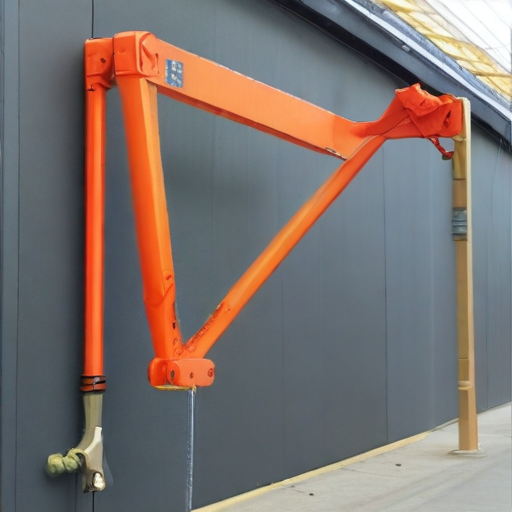
List “wall mount jib crane” FAQ
Wall Mount Jib Crane FAQ
1. What is a Wall Mount Jib Crane?
– A wall mount jib crane is a type of crane that is affixed to a wall, requiring no floor space. It consists of a horizontal jib or boom that supports a movable hoist.
2. What are the common applications?
– These cranes are ideal for loading docks, workstations, and machining/fabrication shops. They provide localized lifting and positioning capabilities.
3. What are the weight capacities available?
– Wall mount jib cranes can typically handle loads from 100 lbs up to several tons, depending on the model and manufacturer specifications.
4. What is the typical span of the boom?
– The span, or reach, of the boom generally ranges from 5 to 20 feet, though it can be customized for specific needs.
5. What is the rotation angle?
– The jib arm can usually rotate 180 degrees or more, providing substantial coverage in a semi-circular area.
6. Do I need special wall support or reinforcement?
– Yes, the wall must be able to support the weight and the dynamic forces involved. Often, structural engineers are consulted to ensure wall integrity.
7. What types of hoists can be used?
– Various types, including manual, electric, or pneumatic hoists, can be used depending on the specific requirements and capacity.
8. How is the crane installed?
– Installation typically involves mounting the jib bracket to a sturdy wall or vertical column using bolts and brackets as per manufacturer guidelines.
9. Is maintenance required?
– Routine maintenance such as checking bolts, lubricating moving parts, and inspecting the hoist mechanism is crucial for safe and efficient operation.
10. What safety features are included?
– Safety features may include locking mechanisms, overload protection, and emergency stop functions to enhance operational safety.
This concise FAQ provides essential information on wall mount jib cranes, addressing common queries to help users better understand their functionality and requirements.
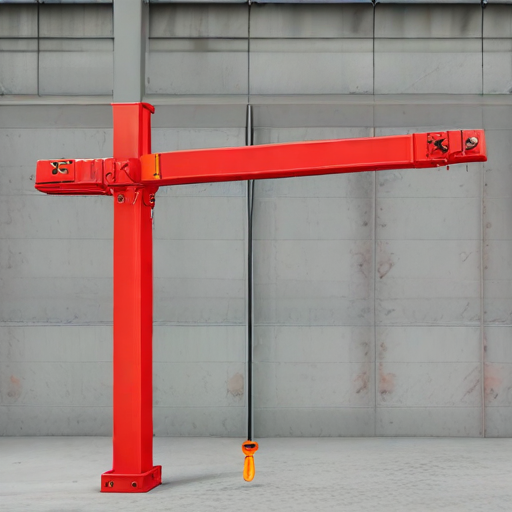
Top 10 FAQ with answer about wall mount jib crane for Buyer Sourcing from China
Certainly! Here are the top 10 frequently asked questions (FAQs) with concise answers for buyers sourcing wall mount jib cranes from China:
1. What is a wall mount jib crane?
– A wall mount jib crane is a lifting device fixed to a wall or column, featuring a horizontal jib (arm) that supports a hoist and enables lifting and moving loads within a 180-degree area.
2. What are the main advantages of wall mount jib cranes?
– They save floor space, are cost-effective, easy to install, and provide efficient material handling in confined or specific workstations.
3. What should I consider when selecting a wall mount jib crane?
– Consider load capacity, span (length of the jib), height under the boom, rotation angle, material of construction, and specific application requirements.
4. How much load can a wall mount jib crane handle?
– Load capacities typically range from 100 kg to 5,000 kg, but always check manufacturer specifications to ensure it meets your needs.
5. What are common materials used in wall mount jib cranes?
– The cranes are usually made from high-strength steel with anti-corrosive coatings. Specific components like the hoist can include additional materials depending on the design.
6. How do I ensure the quality of a wall mount jib crane from China?
– Verify the manufacturer’s certifications (ISO, CE), request product samples, conduct factory audits, and check for compliance with relevant standards (e.g., ASME, EN).
7. What is the typical lead time for manufacturing and delivery?
– Lead times vary but generally range from 4 to 8 weeks. This can depend on the complexity of the order and the manufacturer’s capacity.
8. What kind of after-sales support is available?
– Reputable manufacturers offer warranties, spare parts availability, and support for installation, maintenance, and troubleshooting. Be sure to clarify these terms before purchase.
9. Are custom designs available?
– Many Chinese manufacturers offer customization to meet specific operational requirements. Provide detailed specifications to get an accurate quote and design proposal.
10. What is the typical cost of wall mount jib cranes from China?
– Costs vary based on specifications and customizations but typically range from $1,000 to $10,000. Always request detailed quotations and compare multiple suppliers.
By addressing these key FAQs, buyers can make informed decisions when sourcing wall mount jib cranes from China.

